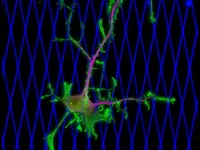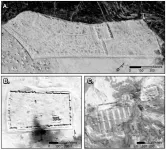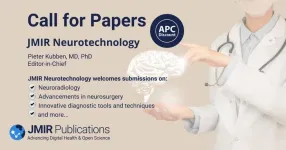(Press-News.org) DALLAS, October 27, 2023 — Approximately 50 million people in the United States are at higher risk for heart disease and/or stroke because they lack the most basic needs — healthy food, clean air and drinking water, quality education, employment, housing and access to health care. Historically, people of color -- including Black and Hispanic/Latino people, are at even higher risk of cardiovascular disease (CVD) for these same reasons. Through the American Heart Association’s 2023 EmPOWERED to Serve Business Accelerator™, three local social entrepreneurs have been awarded cash grants to continue the innovative work they are doing to address health inequities at the community level nationwide. The American Heart Association, a global force for longer healthier lives for all, has recognized these individuals from a group of twelve finalists who participated in the program.
Now in its seventh year, the Business Accelerator has engaged and celebrated the work of more than 100 individuals, non-profits and for-profits who are developing innovative ways to impact the health of the communities where they live, work and play. This year, the top 20 applications out of more than 200 were selected based on the strength of their existing business models as well as their ability to measurably impact health equity barriers. The finalists were then formally evaluated by the Association’s professional science health metrics team and scored based on a variety of criteria -- health impact, innovation and scalability. From this group, twelve individuals were then invited to participate in the six-week Business Accelerator “experience” and were challenged to identify and address a specific, measurable, health impact case study challenge. Responses to this case study challenge were evaluated and refined using design-thinking principles and data-driven customer discovery analyses. Finalist candidates were challenged to blend their “moonshots” with the practical business models taught as part of the program. Final grant recipients were ultimately selected by an independent panel that included tech entrepreneurs and small business investment experts and reviewed on October 19, 2023.
Three cash grants totaling $67,000 were awarded to the following entrepreneurs for their efforts:
1. $50,000 – Anna Li, a fourth-year M.D. and Ph.D. student at the University of Pittsburgh and Carnegie Mellon University, is the founder and CEO of Korion Health. She is a patient and patient advocate who has designed an electronic stethoscope for people to perform heart and lung screenings at home. Inspired by telemedicine visits that required patients to make in-person doctor’s appointments following a telephone or virtual consultation, the stethoscope includes a guided interface with a light to show where to put the stethoscope to capture the correct reading, thereby reducing the need for some patients to travel to visit a doctor.
2. $12,000 – Shavini Fernando, a web designer and developer who specializes in video games and virtual reality, created OxiWear after being diagnosed with severe pulmonary hypertension. OxiWear is the first ear-wearable pulse oximeter for continuous oxygen monitoring and low oxygen warning for those at risk of hypoxia, a condition in which oxygen is not available in sufficient amounts at the tissue level to maintain adequate delivery.
3. $5,000 – Receiving the most votes by visitors to the event website in the fourteen days prior to the finale, the “fan favorite” grant went to Ashley Keyes, executive chef at the Center Helping Obesity In Children End Successfully (C.H.O.I.C.E.S.). where she works with children in schools to make food art and helps solve food insecurity issues facing Atlanta families. The C.H.O.I.C.E.S. Community Teaching Kitchen Project enables her to use her culinary expertise and life experiences while she conducts children’s summer camps, and family cooking classes and hosts mobile food pantries for communities.
Each of the nine remaining finalists received $1,000.
“Since 2017, the American Heart Association, with the support of corporate sponsors, has awarded more than $1.1 million to help accelerate start-ups and provide needed assistance to social entrepreneurs and support organizations addressing the social determinants of health in their communities,” said Nancy Brown, chief executive officer of the American Heart Association. “With the knowledge gained in the EmPOWERED to Serve Business Accelerator, these local change makers can take the next steps to improve health and wellness where they are needed most. We are eager to see the innovative breakthroughs that will come from this experience.”
About the Business Accelerator
The application process ran from May through June 2023 and selected candidates participated in six weeks of intensive, online business training immediately following their selection into the Accelerator. The program’s core curriculum offers formal instruction on design thinking, customer discovery, market positioning, brand development, fundraising, and other essential business functions to help entrepreneurs enhance their business models and demonstrate the viability of projects.
Participant plans and presentations were judged by a panel of experts in the business, community and health sectors including Jason Barnett, senior vice president at Invest with Detroit, Courtney Couch, strategic advisor for Path Water & the VP of Marketing at Interscope Geffen Records, and Colby Takeda, MPH, MBA, co-founder, and chief executive officer of Pear Suite.
The finale was emceed by ShantaQuilette Carter Williams, an entrepreneur, inspirational and motivational speaker, and social media creator. For over twenty years, Ms. Carter Williams has used beauty, fashion and lifestyle to engage, entertain and inspire women from all walks of life.
View the full list of participants and details about the EmPOWERED to Serve Business Accelerator here.
Additional Resources:
Multimedia is available on the right column of the release link.
Spanish news release will be added as available.
United Way ALICE: The Consequences of Insufficient Income 2017 Report
Follow AHA/ASA news on X @HeartNews
###
About the American Heart Association
The American Heart Association is a relentless force for a world of longer, healthier lives. We are dedicated to ensuring equitable health in all communities. Through collaboration with numerous organizations, and powered by millions of volunteers, we fund innovative research, advocate for the public’s health and share lifesaving resources. The Dallas-based organization has been a leading source of health information for nearly a century. Connect with us on Heart.org, Facebook, X or by calling 1-800-AHA-USA1.
END
UNIVERSITY PARK, Pa. — The most lethal feature of any cancer is metastasis, the spread of cancer cells throughout the body. New research led by Penn State reveals for the first time the mechanics behind how breast cancer cells may invade healthy tissues. The discovery, showing that a motor protein called dynein powers the movement of cancer cells in soft tissue models, offers new clinical targets against metastasis and has the potential to fundamentally change how cancer is treated.
“This discovery marks a paradigm shift in many ways,” said Erdem Tabdanov, assistant professor of pharmacology at Penn State and a lead co-corresponding author on the study, recently published ...
Two-thousand years ago, forts were constructed by the Roman Empire across the northern Fertile Crescent, spanning from what is now western Syria to northwestern Iraq.
In the 1920s, 116 forts were documented in the region by Father Antoine Poidebard, who conducted one of the world's first aerial surveys using a WWI-era biplane. Poidebard reported that the forts were constructed from north to south to establish an eastern boundary of the Roman Empire.
A new Dartmouth study analyzing declassified Cold War satellite ...
JMIR Neurotechnology, published by JMIR Publications, welcomes submissions from researchers, clinicians, caregivers, and technologists that explore novel diagnostic and treatment tools for neurological disorders, particularly those leveraging the potential of neurotechnology.
The scope of the journal includes but is not limited to:
Neuroradiology
Advancements in neurosurgery
Innovative diagnostic tools and techniques
Cutting-edge neurotechnology for therapeutics
Data sharing and open science in neurotechnology
Code ...
COLUMBUS, Ohio – A new study from The Ohio State University Wexner Medical Center and College of Medicine, University of Utah and University of Exeter (UK) substantiates previous groundbreaking research that rumination (overthinking) can be reduced through an intervention called Rumination-focused Cognitive Behavioral Therapy (RF-CBT). In addition, the use of fMRI technology allowed researchers to observe correlated shifts in the brain connectivity associated with overthinking.
Study findings are published online in the journal Biological Psychiatry Global Open Science.
“We know adolescent ...
A new Antarctic ice sheet modeling study from scientists at UC San Diego’s Scripps Institution of Oceanography suggests that meltwater flowing out to sea from beneath Antarctic glaciers is making them lose ice faster.
The model’s simulations suggest this effect is large enough to make a meaningful contribution to global sea-level rise under high greenhouse gas emissions scenarios.
The extra ice loss caused by this meltwater flowing out to sea from beneath Antarctic glaciers is not currently accounted for in the models generating major sea-level ...
ITHACA, N.Y. – More than merely cracks in the ice, crevasses play an important role in circulating seawater beneath Antarctic ice shelves, potentially influencing their stability, finds Cornell University-led research based on a first-of-its-kind exploration by an underwater robot.
The remotely operated Icefin robot’s climb up and down a crevasse in the base of the Ross Ice Shelf produced the first 3D measurements of ocean conditions near where it meets the coastline, a critical juncture known as the grounding zone.
The robotic survey revealed a new circulation pattern – a jet funneling water sideways through the crevasse – in addition to rising and sinking currents, ...
A team led by CNRS scientists1 has discovered that, just like humans, Guinea baboons develop complex strategies to select partners for cooperation, basing their decisions on past interactions. Humans naturally engage in strategic cooperation in many contexts. For example, when children help schoolmates by lending them their class notes, they may expect the same in return the next time: this is known as reciprocity. But if the favour is not returned, they are likely to seek others with whom to cooperate.
The team’s findings ...
Imperial researchers have discovered a hidden mechanism within hair follicles that allow us to feel touch.
Previously, touch was thought to be detected only by nerve endings present within the skin and surrounding hair follicles. This new research from Imperial College London has found that that cells within hair follicles – the structures that surround the hair fibre – are also able to detect the sensation in cell cultures.
The researchers also found that these hair follicle cells release the neurotransmitters histamine and serotonin in response to touch – findings that ...
A new large-scale study led by researchers at the University of Cincinnati and Northwell Health, New York's largest health care provider, found the drug metformin can help prevent or reduce weight gain in youth taking medication to treat bipolar disorder.
The collaborative team presented its findings during a symposium at the American Academy of Child and Adolescent Psychiatry conference in New York City Oct. 27.
Weight gain side effect
Medications to treat bipolar disorder, known as second-generation antipsychotics (SGAs), are often effective at helping young ...
By April Toler
More than two-thirds of the world’s population is expected to live in cities by 2050, according to the United Nations. As urbanization advances around the globe, researchers at the University of Notre Dame and Stanford University said the quality of the urban physical environment will become increasingly critical to human well-being and to sustainable development initiatives.
However, measuring and tracking the quality of an urban environment, its evolution and its spatial disparities is difficult due to the amount of on-the-ground data needed to capture these patterns. To address the issue, Yong Suk Lee, assistant professor of technology, ...






